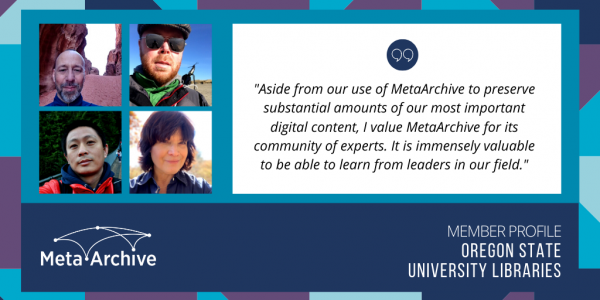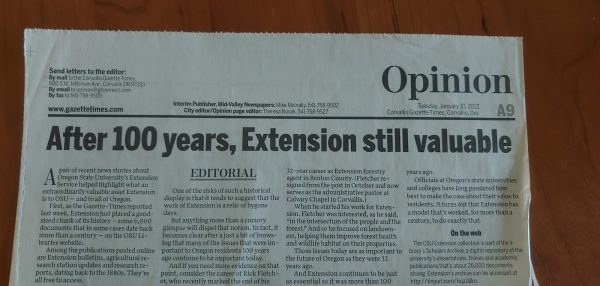MetaArchive Member Profile: Oregon State University Libraries
May 28, 2020
By: Michael Boock, Associate Professor/Scholarly Communication Librarian

Tell us a bit about the digital preservation program at your organization?
Oregon State University Libraries has been firmly committed to the long term preservation of the scholarship of the university and its unique digital assets as far back as 2008 when Terry Reese was appointed to an endowed position with responsibilities for building the digital preservation infrastructure of the Libraries. During his tenure, the Libraries began using LOCKSS for preserving journal content and joined the MetaArchive Cooperative as a sustaining member. Our digital preservation operations were vastly improved after 2012 with the hire of Brian Davis as Digital Production Unit Head , who developed format-specific identification, validation, characterization, and fixity checking of digitized content. The Libraries further committed to digital preservation in a 2012-2017 strategic plan that called for the creation of a “robust and flexible digital preservation and curation infrastructure” and “a long-term preservation system for university scholarship and digital collections developed and curated by OSU Libraries and Press.”
Looking ahead, what are you excited about, or what’s on the horizon for your program?
Brian and I presented a report to library leadership in 2017 that described the current state of the library’s digital preservation efforts and recommended next steps for preserving the Libraries digital objects. Emblematic of how quickly things are changing in the digital preservation space, many of the report recommendations have shifted over the last couple of years, but I am thrilled to say that some of the recommendations, in particular upgrading the library’s backup and storage systems to include monthly and incremental daily backups and the increased use of Archivematica for processing digital objects before repository ingest.

Pictured, Top Row, L-R: Michael Boock, Associate Professor/Scholarly Communication Librarian; Brian Davis, Digital Production Unit Supervisor. Bottom Row, L-R: Hui Zhang, Associate Professor/Digital Services Librarian; Margaret Mellinger, Associate Professor/Director, Emerging Technologies and Services
Tell us a bit about your local workflow. How has the MetaArchive preservation storage service been incorporated?
As noted, for digitized objects, a breadth of preservation work is done to ensure content validation and fixity for digitized objects. The master, preservation-level files are then moved onto ZFS storage systems via a BagIt protocol. For born-digital scholarship housed in the Samvera/Fedora based ScholarsArchive@OSU institutional repository, file integrity using a checksum tool is checked as part of file ingestion. Dr. Hui Zhang, digital services librarian, uses a script that traverses the hierarchy of repository objects in the institutional repository to locate and export binary files with the RDF metadata from specific repository collections. The generated BAGs are then moved to temporary Amazon Web Services storage for MetaArchive harvesting.
What types of digital collections are you focusing on for preservation in MetaArchive? What will preserving those collections for the long-term mean for their users or your institution? How are some of those collections used now?
The Libraries first used MetaArchive to replicate the university’s corpus of Electronic Theses and Dissertations. Theses and dissertations represent the breadth of significant research and scholarship conducted at the university over its entire history, and also serve as an important historical record of the OSU research and teaching interests. MetaArchive is also used to replicate all of the University’s Extension and Experiment Station Communication Publications (EESC). As noted in this editorial from the Corvallis Gazette-Times, published after the EESC collection of over 6,000 technical reports were digitized and made available in the IR, many of the same issues that were important to Oregon residents 100 years ago continue to be important today. Preserving this content with MetaArchive’s robust Private LOCKSS network helps to ensure that it will be available to citizens today and long into the future.

Editorial from the Corvallis Gazette-Times, published after the EESC collection of over 6,000 technical reports were digitized and made available in the IR, noted that many of the same issues that were important to Oregon residents 100 years ago continue to be important today.
Tell us about your experience in participating in the MetaArchive community. How has it influenced you or your work?
I have personally served as OSU’s representative on the MetaArchive Steering Team since 2015 and as this year’s Chair of the Steering Team. When I joined the Steering Team five years ago, I had a strong interest in digital preservation, but I had very little idea about how to do it. As noted above, OSU Libraries has invested in staff and resources to improve digital preservation operations, but this work should not be done in a vacuum. Aside from our use of MetaArchive to preserve substantial amounts of our most important digital content, I value MetaArchive for its community of experts. It is immensely valuable to be able to learn from leaders in our field such as Katherine Skinner, Matt Schultz, and Sam Meister (former MetaArchive Community Manager), and to learn from colleagues from a variety of different library and museum types about their preservation work.
Tell us a bit about your experience participating in the Changing for Continued Impact Series? What have been some of your key takeaways from the series thus far?
As Katherine Skinner (Executive Director of Educopia) noted to members last year, MetaArchive, as the world’s longest tenured distributed digital preservation solution in the world, has been in place and operating within the same technology base and governance structure since its inception. As part of this Series, our community has had an opportunity to hear from experts in the field about alternative technological approaches. It has been invaluable to me to learn from experts in the field, and MetaArchive’s own experts like Nathan Tallman (Penn State) and Zach Vowell (Cal State Poly), that there are alternative solutions that are ripe for further exploration by the community. Another key takeaway for me is that MetaArchive will remain viable as a preservation network only so long as we are prepared to transition to meet the needs of the community. Fortunately, the transparency of the network and its governance structure helps to ensure that the community’s needs will continue to be met.
Editorial note: “Since late 2019 the MetaArchive community has been undergoing a series of intensive evaluations of both their organizational model as well as their technical approaches to distributed digital preservation (DDP). This is the Changing for Continued Impact (CFCI) Series, a facilitated framework led by Educopia that engages the MetaArchive members in a series of focused-discussions and work-sessions. This generative and co-creative process got underway in earnest this past Fall 2019, and will continue through Spring 2020 leading up to the next Annual MetaArchive Membership Meeting.”